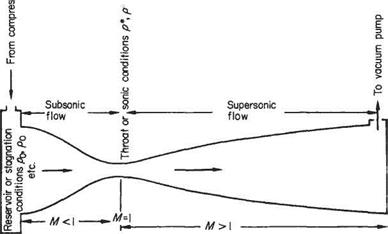Isentropic one-dimensional flow
For many applications in aeronautics the viscous effects can be neglected to a good approximation and, moreover, no significant heat transfer occurs. Under these circumstances the thermodynamic processes are termed adiabatic. Provided no other irreversible processes occur we can also assume that the entropy will remain unchanged, such processes are termed isentropic. We can, therefore, refer to isentropic flow. At this point it is convenient to recall the special relationships between the main thermodynamic and flow variables that hold when the flow processes are isentropic.
In Section 1.2.8 it was shown that for isentropic processes p = kp1 (Eqn (1.24)), where A: is a constant. When this relationship is combined with the equation of state for a perfect gas (see Eqn (1.12)), namely p/(pT) = R, where R is the gas constant, we can write the following relationships linking the variables at two different states (or stations) of an isentropic flow:
|
Pi _ Pi PT P2T2 |
Pf_P2 Pi Pi |
(6.1 |
|
Y – (T’ = T Vp,/ |
rp2(l~’)h w |
(6.2 |
|
From these it follows that |
A useful, special, simplifed model flow is one-dimensional, or more precisely quasi – one-dimensional flow. This is an internal flow through ducts or passages having slowly varying cross-sections so that to a good approximation the flow is uniform at each cross-section and the flow variables only vary with. v in the streamwise direction. Despite the seemingly restrictive nature of these assumptions this is a very useful model flow with several important applications. It also provides a good way to learn about the fundamental features of compressible flow.
 |
|
The equations of conservation and state for quasi-one-dimensional, adiabatic flow in differential form become
which, on dividing through by it1 A and using the identity M2 = tPja2 = рм2/(тр),* using Eqn (1.6d) for the speed of sound in isentropic flow becomes
![]() Й=-7М2^
Й=-7М2^
p u
Likewise the energy Eqn (6.5), with cpT — a2/(7 — 1) found by combining Eqns (1.15) and (1.6d), becomes
![]() dT T
dT T
Then combining Eqns (6.7) and (6.8) to eliminate dр/р and substituting for dр/р and dT/T gives
(6.12)
* M is the symbol for the Mach number, that is defined as the ratio of the flow speed to the speed of sound at a point in a fluid flow and is named after the Austrian physicist Ernst Mach. The Mach number of an aeroplane in flight is the ratio of the flight speed to the speed of sound in the surrounding atmosphere (see also Section 1.4.2).
Equation (6.12) indicates the way in which the cross-sectional area of the stream tube must change to produce a change in velocity for a given mass flow. It will be noted that a change of sign occurs at M = 1.
For subsonic flow <L4 must be negative for an increase, i. e. a positive change, in velocity. At M = 1, dA is zero and a throat appears in the tube. For acceleration to supersonic flow a positive change in area is required, that is, the tube diverges from the point of minimum cross-sectional area.
Eqn (6.12) indicates that a stream tube along which gas speeds up from subsonic to supersonic velocity must have a converging-diverging shape. For the reverse process, the one of slowing down, a similar change in tube area is theoretically required but such a deceleration from supersonic flow is not possible in practice.
Other factors also control the flow in the tube and a simple convergence is not the only condition required. To investigate the change of other parameters along the tube it is convenient to consider the model flow shown in Fig. 6.1. In this model the air expands from a high-pressure reservoir (where the conditions may be identified by suffix 0), to a low-pressure reservoir, through a constriction, or throat, in a convergent-divergent tube. Denoting conditions at two separate points along the tube by suffices 1 and 2, respectively, the equations of state, continuity, motion and energy become
![]()
![]() Pi Pi
Pi Pi
PT P2T2
ріщАі = p2U2A2
piufA 1 – P2i^2A2+piAi – p2A2+{pi+P2){A2~A{) =0 (6.15)
![]()
 |
|
(6.16)
The last of these equations, on taking account of the various ways in which the acoustic speed can be











